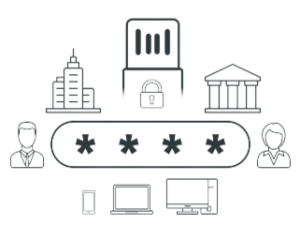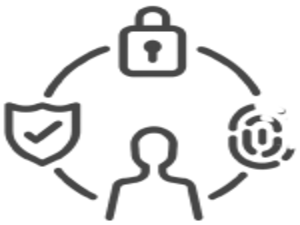Identity Protection (MFA)
Identity Protection (MFA) !
Identity Protection through (MFA) adds an extra layer of security by requiring users to verify their identity using multiple credentials.
This significantly reduces the risk of unauthorized access to sensitive information and enhances overall cybersecurity posture.



A security technique called multi-factor authentication (MFA) uses several credentials to confirm a user’s identity. MFA requires extra credentials, such as a code from the user’s smartphone, a response to a security question, a fingerprint, or facial recognition, in addition to the standard login and password.
Enhanced security can be effectively achieved with MFA. Conventional usernames and passwords are increasingly susceptible to brute force attacks and can be stolen. To help boost trust that the person requesting access is indeed who they say they are, MFA adds many layers of security. A cybercriminal may steal one credential with MFA, but they will be stopped since they must use a different method to confirm their identity.
Using a combination of these components for authentication is an example of multi-factor authentication:
- codes produced by applications on smartphones
- USB devices, badges, or other tangible objects
- Soft tokens and certifications
- The prints of fingers
- codes that are delivered by email
- Recognizing faces
- Iris or retinal scanning
- Analysis of behavior
- Score for risk
- Responses to inquiries on personal security
Kinds of factors used for authentication
Three different kinds of authentication elements are commonly referred to when discussing MFA:
- Things that you are aware of, such a PIN or password
- Items that you possess, such a smartphone or badge
- Things that identify you (inheritance), as demonstrated by voice recognition or fingerprints
The most recent MFA systems take into account context and behavior in addition to other variables when authenticating. As an illustration:
- Wherever you are (e.g., house or cafe) when attempting to gain access
- During the working day or late at night, when you are attempting to access
- Which device are you using—for example, a laptop or a smartphone?
- Which type of network—public or private—are you utilizing?
This kind of multi-factor authentication, also known as adaptive authentication, flags unusual login attempts by taking context into consideration. Adaptive MFA has the potential to tighten security by requesting additional credentials when someone attempts to authenticate in an unexpected setting. For instance, the MFA tool might ask the user to input a code that is texted to their phone if they are signing in late at night from a cafe and this is not how they usually log in.
In any organization, multi-factor authentication is essential for maintaining user identity, protecting corporate network access, and verifying that a user is who they say they are.
Access control requires whole new considerations due to evolving business needs surrounding cloud applications and mobile devices, as well as growing threats and the desire to cut costs.
One component of access management is authentication. Solutions for identity and access management offer a structure for approving and rejecting application access, enforcing access restrictions, and guaranteeing visibility into access events. SafeNet Trusted Access can help with that.
Granular access security and the ease of single sign-on are combined in SafeNet Trusted Access, an access management solution. Organizations may provide safe, practical access to multiple cloud and web-based apps from a single, user-friendly dashboard by verifying identities, enforcing access controls, and implementing smart single sign-on.
Why is multi-factor authentication necessary?
Growing business requirements and new risks, vulnerabilities, and threats highlight the need for a robust authentication strategy built on choice, ease of use, and future-proof scalability.
Today, organizations are asking:
- Can I meet my company’s new requirements, which include cloud and mobile devices?
- How can I align the needs of my users and business risk with access control methods?
- Can I administer, manage, and control all of my endpoints and users from a single location?
- Who is in charge of my user information?How can I strengthen my defenses against threats even more by implementing more security layers?
- And how can I make everything realistic and affordable?
Customers are searching more than ever for identity and access management systems that offer automation, choice, simplicity, and lower total cost of ownership.
Our multi-factor authentication software gives you the safety you need and gives your consumers more options, better visibility, and future growth potential. Consequently, businesses utilizing our MFA software have:
- Better self-control of data – We enables customers with the option to create and control their own token data, so there is no reliance on a third-party vendor
- Improved management and visibility – Our solutions deliver single-server management, providing full control, simple administration, and reduced cost and staff burden
- Expanded options – We delivers the broadest choice when it comes to access security methods – so you can meet the needs of any user and any risk level (hardware or software, certificate-based authentication or traditional one-time-password, on-premise, or into the cloud)
- Future-ready solutions – We provide new solutions that deliver MFA and single sign-on (SSO) for cloud applications as well as credentialing for mobile device management
- Painless migrations – We offer seamless migration to cloud-based authentication, which maintains your existing investments and causes no disruption to end-users
